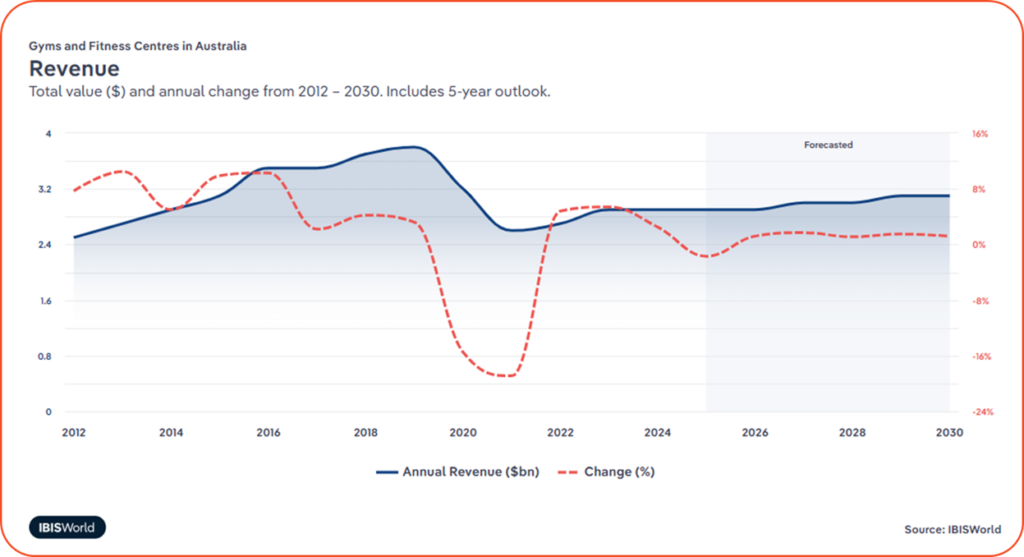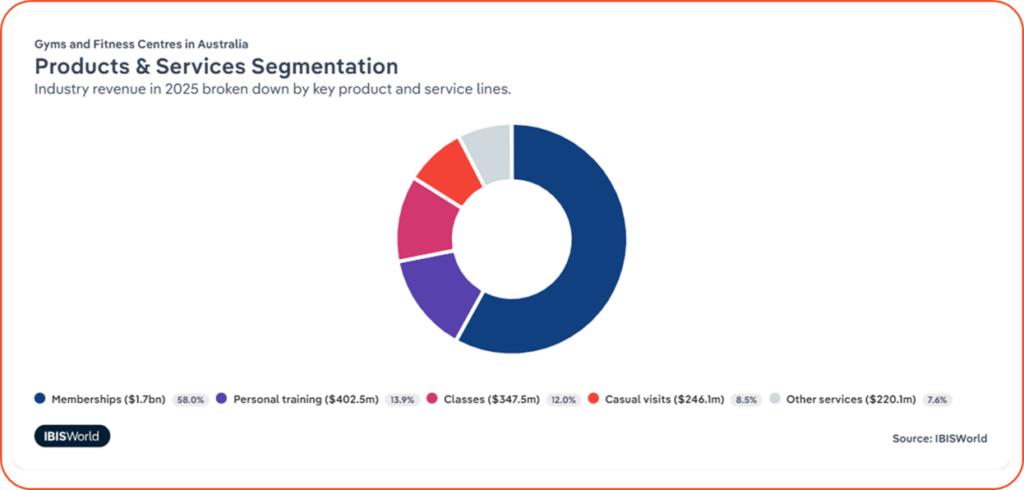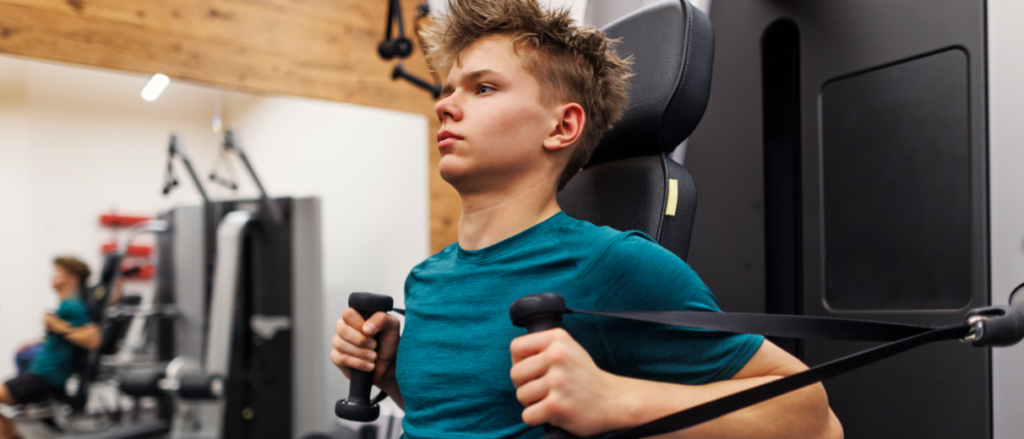The fitness industry is always evolving driven by technological innovation, shifting consumer expectations, and a renewed focus on health and wellbeing. 2025 is set to be another exciting year of change for the industry. If you were at the Beyond Activ APAC Festival you would have heard Michelle Furniss, General Manager of Xplor Gym, share 24 insights form 2024 and what to expect in 2025. Don’t worry, if you missed it, we’ve got it all here for you!
Here’s a deep dive into these insights, in no particular order, designed to help gym owners and operators adapt and thrive.

1: Health & Fitness Remains a Priority
Australians are still making fitness a top priority, despite economic pressures 💪
he Australian fitness industry has faced its share of challenges over the past few years. According to the latest IBISWorld report on Gyms and Fitness Centres in Australia, the sector took a 20% revenue hit during the pandemic due to lockdown closures. Many gyms, especially independent operators, dealt with mounting debts and operational struggles as a result.
But here’s the good news: membership numbers surged once restrictions lifted, showing that Australians are determined to stay active. While rising living costs and inflation continue to squeeze household budgets, health and fitness remain essential for many. People are willing to invest in their well-being—even if they’re more selective about where they spend.
A 2024 market report revealed that fitness spending in Australia alone exceeds $8.5 billion annually, with under-35s making up nearly 50% of gym members. With wellness becoming an integral part of daily life, gym owners can expect continued demand for their services well into 2025.
How gyms can respond:
To stay relevant, fitness operators should highlight how exercise benefits both body and mind. Tailor marketing campaigns to showcase health, wellness, and community-driven activities. Offering memberships with added wellness perks like guided meditations, mental health workshops, or recovery services can increase value perception.
2: The Rise of Wearable Technology
Wearables are becoming fitness must-haves ⌚
Wearable fitness tech is no longer just a trend—it’s a way of life. Smartwatches, fitness trackers, and even tech-embedded clothing are reshaping how Australians approach their workouts. These devices don’t just count steps anymore—they track heart rate, sleep patterns, stress levels, and more.
Fitness enthusiasts in Australia and New Zealand are using wearable tech to stay motivated, set goals, and measure progress like never before. For gyms, integrating wearable data into member experiences can unlock new ways to personalise training and boost engagement.
The Fitness-Tracker market in New Zealand is projected to grow by 5.96% (2024-2029)
What gyms can do:
Integrate wearable tech into gym operations by launching fitness challenges based on wearable data or offering app integrations for tracking workouts. Consider hosting wearable-specific events like step count contests or heart-rate zone training sessions.

3: Recurring Memberships Remain a Staple
Memberships continue to be the core revenue driver 💸
Recurring memberships have always been the foundation of the fitness industry, and they remain just as critical in 2024. With memberships making up 58% of gym revenue, these long-term commitments continue to provide gyms with predictable, stable income. After the pandemic, we saw a strong return of gym-goers who were eager to get back to in-person training, with many prioritising their health and fitness once again.
However, in an unpredictable market where the rising cost of living and inflation are top of mind for many, the growth of membership sign-ups is expected to slow. As a result, gym owners must place even more focus on keeping existing members engaged, ensuring that the memberships they have continue to drive long-term value.
Why it matters:
While casual visits and class-based options like Yoga and Pilates are growing, recurring memberships still hold the key to long-term financial stability. Members who commit to regular payments are more likely to stay engaged and benefit from the full range of gym offerings. But in a world where everything feels uncertain, it’s more important than ever to make members feel like their membership is something they genuinely value and want to maintain.
How gyms can maintain strong memberships:
- Focus on Experience: Keep members coming back by offering a fitness experience that feels personalised and rewarding, so they look forward to each visit.
- Member Retention: Provide ongoing support and check-ins, such as progress updates, to reinforce the value of the membership and motivate long-term commitment.
- Exclusive Perks: Reward loyalty with exclusive offers or special access to premium services like personal training, special events, or members-only classes.
4: Corporate Wellness Is Non-Negotiable
Workplace wellness becomes a business must-have 🏢
Gone are the days when workplace wellness was a “nice-to-have” perk. Today, it’s a must-have for businesses looking to attract and retain top talent. With hybrid work models here to stay, companies across Australia and New Zealand are investing in employee wellness programmes that include gym memberships, on-site classes, and mental health support.
Fitness operators can tap into this growing market by partnering with local businesses to create customised wellness packages. These partnerships boost revenue while offering companies a competitive edge in today’s health-conscious job market.
Corporate partnerships contribute to 15% of new memberships annually for gyms
How gyms can partner with businesses:
- Custom Packages: Create tailored wellness plans with fitness classes, mental health workshops, and personal training.
- On-Site Fitness Days: Host corporate fitness challenges or wellness events at the office.
- Exclusive Discounts: Offer company-wide memberships at reduced rates.

5: Expanding Wallet Share
Members are willing to spend more when value is clear 💳
Expanding wallet share means increasing how much each member spends by offering services beyond standard memberships. Today’s fitness consumers see fitness as a lifestyle and are happy to invest more when they trust the brand. This includes personal training, nutrition coaching, and branded gear—all of which enhance their experience.
Building trust through exceptional service and personalised recommendations encourages members to spend more. Loyalty programmes, exclusive packages, and personalised rewards can boost both profitability and retention while making members feel more connected to your gym.
What gyms can do:
- Introduce premium membership tiers with personal training and nutrition consults.
- Offer bundled service packages or event access for extra value.
- Create targeted promotions that highlight premium services and upgrade
6: The Fitness-Wellness Intersection
Fitness and wellness merge into a holistic experience 🧘
The integration of fitness and wellness is becoming a standard offering in Australia and New Zealand gyms, with more members seeking balance between physical and mental well-being. Workouts are no longer just about lifting weights or running on a treadmill—they’re about creating a complete wellness experience that includes recovery, relaxation, and mindfulness.
Gyms are adding dedicated recovery areas, mindfulness rooms, and services like massage therapy, infrared saunas, and even meditation sessions. This shift reflects a growing understanding that rest and mental health are just as important as exercise.
Gyms with recovery zones see a 40% increase in premium memberships
How gyms can respond:
- Create Recovery Spaces: Add stretching zones, foam rolling stations, and relaxation areas.
- Host Wellness Workshops: Offer mindfulness, meditation, and stress management classes.
- Partner with Wellness Brands: Collaborate with local wellness providers for special events.
7: Personalisation Is Everything
Tailored fitness experiences drive engagement 👟
COVID has taught us the deep importance of connection and personalisation. Personalisation has moved from being a bonus feature to an essential part of the gym experience. Members expect workouts, nutrition plans, and even marketing messages to be customised to their individual goals and preferences. Gyms that offer tailored fitness solutions see higher engagement and retention rates.
Fitness tech, data tracking, and customer relationship management (CRM) software make personalisation more achievable than ever. Members want personalised fitness assessments, goal-specific training plans, and customised class recommendations that fit their unique fitness journeys.

How gyms can personalise experiences:
- Fitness Consultations: Offer free initial consultations to set personalised goals.
- Member Profiles: Use CRM systems to track workout history and progress.
- Tailored Campaigns: Send personalised marketing messages based on individual fitness data.
- Authentic Interactions: Ensure every personalised message feels genuine
8: Exercise as Medicine
Exercise becomes a key prescription for health issues 💊
Healthcare professionals in Australia and New Zealand are increasingly prescribing exercise to manage and prevent chronic conditions such as diabetes, heart disease, and depression. The concept of “exercise as medicine” has gained traction, encouraging collaborations between fitness providers and healthcare organisations.
Doctors and physiotherapists often recommend fitness programmes as part of treatment plans. Gyms offering medically supported fitness classes, such as heart health programmes or rehabilitation sessions, can expand their services while boosting credibility in the wellness industry.

How gyms can support this trend:
- Medical Referrals: Partner with healthcare providers for referral programmes.
- Specialist Classes: Offer classes for managing conditions like arthritis or post-injury recovery.
- Trainer Certifications: Invest in trainer education for medically-focused fitness services.
9: Fitness for an Ageing Population
Older adults are embracing fitness like never before 👵🏽
As Australia’s population ages, the fitness industry is experiencing increased demand for senior-specific services. By 2026, 22% of Australians will be over 65, making older adults one of the fastest-growing market segments. They are interested in fitness not only for physical health but also for maintaining independence and social connections.
Age-friendly fitness programmes that focus on mobility, balance, and strength are critical for this demographic. Seniors also value the social aspect of attending classes, making community-driven fitness experiences particularly popular.
According to AUSactive, gyms that offer senior-friendly classes see retention rates 30% higher than those without such programmes. Age-specific memberships and low-impact training have become important selling points.
How gyms can support older members:
- Senior Fitness Classes: Offer balance, mobility, and functional strength classes.
- Adaptive Equipment: Invest in senior-friendly equipment like recumbent bikes and low-impact machines.
- Community Events: Host social events and wellness seminars designed for older adults.
10: Outdoor Fitness Gains Traction
Exercise goes beyond the gym walls 🌿
Outdoor fitness has evolved from a pandemic-era necessity into a permanent fitness trend. Councils and local governments across Australia and New Zealand continue to invest in public workout spaces, providing gyms with opportunities to expand their services outdoors. Outdoor boot camps, yoga classes in parks, and even beach workouts have become highly popular.
Outdoor fitness events not only attract fitness enthusiasts but also appeal to those seeking a less intimidating gym environment. Fresh air, natural surroundings, and flexible workout formats make outdoor fitness particularly appealing for group sessions.
In early 2024, participation in outdoor fitness events in Australia increased by 45% compared to pre-pandemic levels, according to a market study by Wellness Creative Co. The demand for outdoor fitness remains high, especially during warmer months.
How gyms can offer outdoor fitness:
- Seasonal Boot Camps: Organise boot camps and circuit training in parks.
- Beach Workouts: Host coastal yoga, running, or strength training sessions.
- Community Fitness Events: Partner with councils for outdoor fitness festivals or charity runs.
11: Gyms as Community Hubs
Fitness centres evolve into social spaces 🏋️♀️🤝
Gyms are no longer just places to exercise—they’ve become vital community hubs where people connect, socialise, and support each other. For many gym-goers especially post-pandemic, visiting the gym is one of their main and sometime only social activities, offering a supportive environment that extends beyond workouts.
The rise of community-driven classes like group fitness, team challenges, and gym-hosted events has transformed fitness centres into social spaces. Members stay longer and remain loyal when they feel part of a fitness “family.” This trend reflects a broader shift toward fostering connection and belonging in modern fitness environments.
78% of members stay longer in gyms with strong community vibes
How gyms can build a sense of community:
- Social Spaces: Create comfortable seating areas where members can relax and chat.
- Team Challenges: Run gym-wide fitness challenges that encourage teamwork and competition.
- Member Events: Host regular social events like BBQs, charity fundraisers, and themed workout nights.
12: AI-Driven Fitness Coaching
Artificial intelligence enhances the fitness experience 🤖
Artificial intelligence (AI) is AI is revolutionising many industries, and fitness is no different. From AI-powered workout recommendations to automated customer service chatbots, AI-driven technology is helping gyms personalise services at scale, making gym management more efficient and improving member experiences.
The effectiveness of AI depends on the quality and quantity of data it is trained on and this is getting better on the daily And while AI can’t replace human trainers, it serves as a valuable support tool that boosts productivity and enhances customer engagement.
Technology is growing daily, but will never replace humans . A balance between leveraging technology and maintaining human empathy and intuitiveness is key
How gyms can leverage AI:
- Automate Member Support: Use AI chatbots to handle routine member inquiries.
- Personalised Workouts: Offer AI-driven fitness assessments and goal-setting tools.
- Data-Driven Insights: Use AI-powered analytics to track member progress and recommend relevant services.

13: Managing Reversal Rates
Failed payments don’t have to mean lost revenue 💸
Reversal rates remain a challenge for gyms in Australia and New Zealand, accounting for a significant portion of lost revenue. Despite inflation and the rising cost of living, industry reports show that reversal rates have stayed steady at around 3% year-on-year, highlighting that fitness is still a priority for many consumers.
Gyms that offer flexible payment options and adopt frictionless recovery strategies are managing to reduce revenue losses significantly. Efficient systems that notify members of failed payments, offer flexible repayment options, and automate recovery processes are essential for maintaining cash flow and keeping members on track.
According to AUSactive, using advanced payment recovery tools can cut revenue leakage by up to 60%.
What gyms can do:
- Offer Payment Flexibility: Allow various payment methods like direct debit, credit cards, or digital wallets.
- Automate Payment Recovery: Use recovery tools to handle failed payments automatically.
- Clear Communication: Notify members promptly when payments fail, offering simple ways to update details or resolve issues.
14: Contracts vs. Pay-As-You-Go
Flexible memberships win over commitment-shy consumers 🔄
Gym-goers have become more selective about long-term commitments. According to recent industry data, 21% of gym members prefer not to be locked into contracts, reflecting a broader shift driven by the rise of the subscription economy. With services like Netflix and Spotify normalising no-commitment models, ease of cancellation has become a standard expectation.
To adapt, some gym operators are switching to no-lock-in contracts as a way to differentiate themselves from competitors. While 12-month contracts still provide financial stability through predictable recurring income, offering flexible membership options can attract members who value freedom and control over their fitness journey. Balancing both models can maximise revenue while meeting evolving consumer preferences.
What gyms can do:
- Offer Contract-Free Memberships: Provide rolling month-to-month plans to reduce sign-up hesitations.
- Highlight Flexibility: Market ease of cancellation and membership upgrades.
- Customise Plans: Offer hybrid models that blend contract and no-lock-in memberships for broader appeal.
15: The Rise of Functional Training and HIROX
Functional fitness gains competitive edge 🏋️♂️
Functional training has become a major focus for fitness enthusiasts, driven by global events like HIROX and CrossFit competitions. These workout styles emphasise real-world strength, endurance, and mobility by mimicking everyday movements through exercises like squats, lunges, and deadlifts.
HIROX competitions have seen global participation rates double year-on-year, inspiring gyms to offer dedicated functional training areas and group fitness classes. The appeal lies in its combination of strength, cardio, and teamwork—ideal for fitness enthusiasts who enjoy competition and goal-based training.
Searches for “functional training gyms near me” increased by 40% in Australia in 2024, while participation in functional fitness events surged, driven by social media influence and fitness challenges.
How gyms can tap into functional training:
- Dedicated Training Zones: Create HIROX-style training areas with sleds, kettlebells, and ropes.
- Challenge Events: Host in-gym fitness competitions with prizes for top performers.
- Functional Classes: Offer group classes like circuit training, strength-building, and team-based workouts.

16: Ladies Who Lift
Strength training is empowering a new generation of women 💪♀️
More women than ever are embracing strength training, particularly Gen Z and millennials, driven by a sense of empowerment, body confidence, and a desire to build strength—not just aesthetics. Social media has played a huge role in reshaping how strength training is perceived, with platforms like Instagram and TikTok spotlighting female lifters, trainers, and fitness influencers.
Education and inclusive gym environments have helped eliminate the intimidation factor, encouraging more women to pick up weights. The Australian Powerlifting Championships now sees equal participation from men and women—a clear sign of how much the fitness landscape has evolved. Strength training isn’t just about appearance; it’s about health benefits like improved bone density, stabilised joints, and reduced risk of fractures, making it a long-term investment in overall well-being.
What gyms can do:
- Women-Only Classes: Offer women-focused strength training sessions or lifting workshops.
- Supportive Spaces: Ensure gym environments are welcoming, inclusive, and free from intimidation.
- Social Media Campaigns: Share success stories of female lifters to inspire and attract more women.
17: Fitness During Menopause
Menopause-specific fitness programmes gain momentum 🌿
As discussions about menopause become more open and normalised, fitness programmes tailored to this demographic are emerging as a key trend in Australia and New Zealand. Nearly 2 million Australian women are post-menopausal, with many turning to exercise to help manage symptoms like weight gain, reduced bone density, and hormonal imbalances.
Gyms that address these specific health needs by offering low-impact, strength-building, and functional fitness classes will tap into an underserved but rapidly growing market. Education and trainer certifications related to menopause fitness have also gained popularity.

How gyms can support this trend:
- Specialised Classes: Offer fitness classes focused on bone health, flexibility, and core strength.
- Trainer Education: Invest in staff certifications related to menopause fitness.
- Educational Workshops: Host wellness seminars with health professionals to educate members on managing menopause through exercise.

18: Tech & Mobile Apps Dominate
On-demand fitness is now a consumer expectation 📱
The demand for tech-driven fitness experiences continues to rise, with members expecting on-demand access, personalised features, and data-driven insights. Fitness apps are no longer just add-ons—they’re central to how members manage their fitness journeys. Millennials remain the most active users of fitness apps, with women using them twice as much as men.
Consumers are eager for health data, with 46% wanting as much quantifiable information as possible and 54% likely to purchase body-analysing devices. To meet these expectations, gyms should choose tech solutions that enhance the member experience—offering personalisation, progress tracking, and seamless access to bookings and on-demand content. The right tech can drive deeper engagement and long-term loyalty.
What gyms can do:
- App Integration: Offer a gym-branded app for bookings, workout tracking, and fitness updates.
- Personalised Features: Use tech that tracks progress, suggests classes, and tailors fitness plans.
- Data-Driven Tools: Provide members with health insights through body composition scans or wearable device integrations.
19: In-Home Fitness Lives On
Home-based fitness remains a key offering 🏠💪
Despite predictions that in-home fitness would decline post-pandemic, it has continued to thrive. On-demand video classes have seen 300% growth since COVID, showing that many consumers still value the convenience and flexibility of working out at home. This shift aligns with the rise of hybrid working models, where members want fitness options that fit into their changing routines.
Gyms offering blended models that combine in-person training with digital fitness services are best positioned for long-term success. Personal trainers have also adapted, with 80% now providing both online and face-to-face training. Flexibility and accessibility are key—members want the freedom to train wherever and whenever it suits them.
According to Wellness Creative Co., 1 in 3 gym members prefer having access to both in-gym and home-based workouts due to flexibility and convenience.
How gyms can offer hybrid fitness:
- Virtual Class Memberships: Offer digital memberships with access to live and pre-recorded workouts.
- Hybrid Programmes: Include in-home workout plans as part of regular memberships.
- Tech Partnerships: Collaborate with fitness tech companies for at-home workout equipment bundles.
20: Personal Trainers
Personal training stays strong—but attracting talent is a challenge 🏋️♂️
Demand for personal trainers (PTs) in ANZ remains strong, with 80% of trainers now offering online coaching alongside traditional face-to-face sessions. As members continue seeking tailored guidance in a crowded fitness market, PTs have become essential for providing personalised support and accountability.
However, the industry is facing a talent shortage, pushing many brick-and-mortar gyms to adapt how they attract and retain trainers. Offering career development, flexible working conditions, and competitive pay has become crucial in securing top PT talent. Gyms that support hybrid coaching models and create clear growth paths will be better equipped to meet rising member expectation
What gyms can do:
- Offer Career Progression: Provide certifications, mentorship programmes, and advancement opportunities.
- Support Hybrid Roles: Allow PTs to balance in-gym and online coaching.
- Flexible Contracts: Offer competitive pay structures, including revenue-sharing and performance-based bonuses.
21: Re-Engaging Inactive Members (Sleepers)
Bringing dormant members back to the gym 👋
One of the biggest challenges for gyms is re-engaging “sleepers”—members who have stopped attending but haven’t yet cancelled their memberships. With rising competition from at-home fitness platforms, gyms must be proactive in retaining these members by offering personalised reactivation campaigns and outreach programmes.
Sleepers are often willing to return if approached with the right offer, such as tailored incentives, free fitness consultations, or new programme announcements. Personalised communication driven by member data can reignite interest and reduce membership cancellations.
Most members will cancel around 5 months after their last visit.
How gyms can reactivate sleepers:
- Personalised Offers: Send special promotions or discounted personal training sessions.
- Reactivation Campaigns: Launch “We Miss You” email campaigns with time-sensitive offers.
- Free Fitness Reviews: Offer complimentary fitness assessments to reignite motivation.

22: Specialised Training for a Competitive Edge
Niche fitness programmes build member loyalty 🎯
In today’s crowded fitness market, gyms are increasingly adopting specialised training programmes to stand out. From marathon training and boxing boot camps to sports-specific conditioning, offering niche services helps gyms attract fitness enthusiasts with clear goals and specialised interests.
Targeted programmes not only boost member engagement but also increase revenue through premium pricing. With fitness consumers demanding results-driven experiences, specialised training is no longer optional—it’s essential.
Principle of specificity – training that mimics movements of skills required in a sporting event of fitness activity
How gyms can specialise:
- Sports-Specific Training: Offer programmes for sports like running, swimming, or boxing.
- Skill-Focused Classes: Introduce sessions focusing on specific goals like weightlifting or endurance training.
- Expert-Led Workshops: Host masterclasses or clinics led by industry professionals.
23: Genetic Fitness Testing Emerges
DNA-based training takes personalisation to the next level 🧬
Genetic fitness testing is gaining traction as consumers seek hyper-personalised fitness and nutrition plans based on their unique genetic profiles. DNA-based testing can reveal key insights such as fitness potential, nutritional needs, and injury risk—helping members unlock their full potential through customised workout and diet plans.
Though still relatively new in Australia and New Zealand, genetic testing services are becoming popular in premium gym offerings. Fitness businesses incorporating DNA-based services can position themselves as leaders in cutting-edge health and wellness solutions.
How gyms can offer DNA-based services:
- Partner with Testing Providers: Collaborate with certified DNA testing companies.
- Premium Packages: Create membership tiers that include genetic fitness assessments.
- Member Education: Host seminars explaining the benefits of DNA-based fitness planning.
24: Expanding Market Opportunities
New demographics drive fitness growth 📈
Australia and New Zealand’s fitness market continues to expand, with under-35s making up nearly 50% of gym memberships. However, other untapped demographics—such as older adults, corporate clients, and specialised fitness enthusiasts—are emerging as key growth drivers.
Diversifying services to cater to these expanding markets can help gyms capture new revenue streams. Fitness operators should explore opportunities in family fitness, rehabilitation programmes, and even virtual memberships to reach broader audiences.
How gyms can reach new markets:
- Age-Inclusive Programmes: Offer fitness classes for kids, teens, and seniors.
- Corporate Wellness Deals: Expand partnerships with businesses for workplace wellness packages.
- Hybrid Memberships: Introduce digital memberships that include live-streamed and on-demand workouts.

Seize the Future of Fitness
Stay ahead with innovation and adaptability 🚀
As the fitness industry evolves, success will depend on how well gyms adapt to changing member expectations. From tech-driven experiences and personalised services to holistic wellness integration, staying ahead requires constant innovation and a focus on customer-centric services.
The future belongs to fitness providers who embrace data-driven strategies, build strong communities, and deliver exceptional member experiences. Investing in advanced tech, sustainable facility upgrades, and staff development will ensure long-term success in a competitive market.
Growth outlook:
The Australian and New Zealand fitness industry will see continued growth driven by tech adoption, personalisation, and wellness integration. Businesses willing to innovate and embrace new fitness trends will remain industry leaders.
How gyms can future-proof their business:
- Invest in Tech: Upgrade gym management systems and member engagement platforms.
- Create Personalised Services: Offer goal-specific training plans and tailored memberships.
- Build a Fitness Community: Focus on community-driven events, workshops, and member engagement.


by Tayler Maich Commercial Director
-
First published: 16 December 2024
Written by: Tayler Maich
